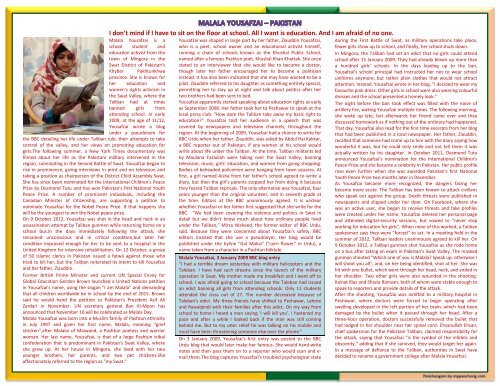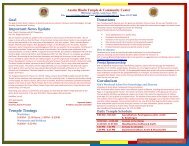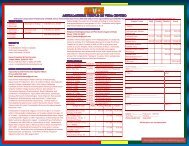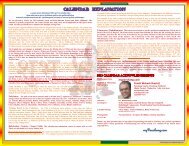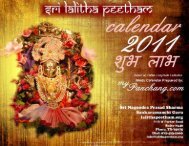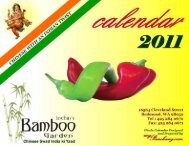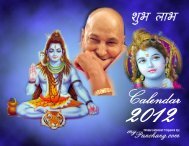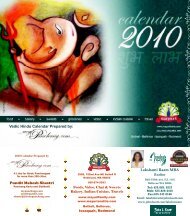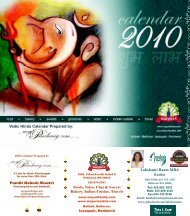Women's Education 2013 Hindu Calendar - myPanchang.com
Women's Education 2013 Hindu Calendar - myPanchang.com
Women's Education 2013 Hindu Calendar - myPanchang.com
- No tags were found...
You also want an ePaper? Increase the reach of your titles
YUMPU automatically turns print PDFs into web optimized ePapers that Google loves.
Malala Yousafzai is aschool student andeducation activist from thetown of Mingora in theSwat District of Pakistan'sKhyber Pakhtunkhwaprovince. She is known forher education andwomen's rights activism inthe Swat Valley, where theTaliban had at timesbanned girls fromattending school. In early2009, at the age of 11/12,Yousafzai wrote a blogunder a pseudonym forthe BBC detailing her life under Taliban rule, their attempts to takecontrol of the valley, and her views on promoting education forgirls.The following summer, a New York Times documentary wasfilmed about her life as the Pakistani military intervened in theregion, culminating in the Second Battle of Swat. Yousafzai began torise in prominence, giving interviews in print and on television andtaking a position as chairperson of the District Child Assembly Swat.She has since been nominated for the International Children's PeacePrize by Desmond Tutu and has won Pakistan's first National YouthPeace Prize. A number of prominent individuals, including theCanadian Minister of Citizenship, are supporting a petition tonominate Yousafzai for the Nobel Peace Prize. If that happens shewill be the youngest to win the Nobel peace prize.On 9 October 2012, Yousafzai was shot in the head and neck in anassassination attempt by Taliban gunmen while returning home on aschool bus.In the days immediately following the attack, sheremained unconscious and in critical condition,but later hercondition improved enough for her to be sent to a hospital in theUnited Kingdom for intensive rehabilitation. On 12 October, a groupof 50 Islamic clerics in Pakistan issued a fatwā against those whotried to kill her, but the Taliban reiterated its intent to kill Yousafzaiand her father, Ziauddin.Former British Prime Minister and current UN Special Envoy forGlobal <strong>Education</strong> Gordon Brown launched a United Nations petitionin Yousafzai's name, using the slogan "I am Malala" and demandingthat all children worldwide be in school by the end of 2015. Brownsaid he would hand the petition to Pakistan's President Asif AliZardari in November. UN secretary general Ban Ki-Moon hasannounced that November 10 will be celebrated as Malala Day.Malala Yousafzai was born into a Muslim family of Pashtun ethnicityin July 1997 and given her first name, Malala, meaning "griefstricken",after Malalai of Maiwand, a Pashtun poetess and warriorwoman. Her last name, Yousufzai, is that of a large Pashtun tribalconfederation that is predominant in Pakistan's Swat Valley, whereshe grew up. At her house in Mingora, she lived with her twoyounger brothers, her parents, and two pet chickens.Sheaffectionately referred to the region as "my Swat."I don’t mind if I have to sit on the floor at school. All I want is education. And I am afraid of no one.Yousafzai was shaped in large part by her father, Ziauddin Yousafzai,who is a poet, school owner and an educational activist himself,running a chain of schools known as the Khushal Public School,named after a famous Pashtun poet, Khushal Khan Khattak. She oncestated to an interviewer that she would like to be<strong>com</strong>e a doctor,though later her father encouraged her to be<strong>com</strong>e a politicianinstead. It has also been indicated that she may have wanted to be apilot. Ziauddin referred to his daughter as something entirely special,permitting her to stay up at night and talk about politics after hertwo brothers had been sent to bed.Yousafzai apparently started speaking about education rights as earlyas September 2008. Her father took her to Peshawar to speak at thelocal press club. "How dare the Taliban take away my basic right toeducation?" Yousafzai told her audience in a speech that wascovered by newspapers and television channels, throughout theregion. At the beginning of 2009, Yousafzai had a chance to write forBBC Urdu when her father, Ziauddin, was asked by Abdul Hai Kakkar,a BBC reporter out of Pakistan, if any women at his school wouldwrite about life under the Taliban. At the time, Taliban militants ledby Maulana Fazlullah were taking over the Swat Valley, banningtelevision, music, girls’ education, and women from going shopping.Bodies of beheaded policemen were hanging from town squares. Atfirst, a girl named Aisha from her father's school agreed to write adiary, but then the girl's parents stopped her from doing it becausethey feared Taliban reprisals. The only alternative was Yousafzai, fouryears younger than the original volunteer, and in seventh grade atthe time. Editors at the BBC unanimously agreed. It is unclearwhether Yousafzai or her father first suggested that she write for theBBC. “We had been covering the violence and politics in Swat indetail but we didn’t know much about how ordinary people livedunder the Taliban,” Mirza Waheed, the former editor of BBC Urdu,said. Because they were concerned about Yousafzai's safety, BBCeditors insisted that she use a pseudonym. Her blog would bepublished under the byline "Gul Makai" ("corn flower" in Urdu), aname taken from a character in a Pashtun folktale.Malala Yousafzai, 3 January 2009 BBC blog entry"I had a terrible dream yesterday with military helicopters and theTaleban. I have had such dreams since the launch of the militaryoperation in Swat. My mother made me breakfast and I went off toschool. I was afraid going to school because the Taleban had issuedan edict banning all girls from attending schools. Only 11 studentsattended the class out of 27. The number decreased because ofTaleban's edict. My three friends have shifted to Peshawar, Lahoreand Rawalpindi with their families after this edict. On my way fromschool to home I heard a man saying 'I will kill you'. I hastened mypace and after a while I looked back if the man was still <strong>com</strong>ingbehind me. But to my utter relief he was talking on his mobile andmust have been threatening someone else over the phone."On 3 January 2009, Yousafzai's first entry was posted to the BBCUrdu blog that would later make her famous. She would hand-writenotes and then pass them on to a reporter who would scan and e-mail them.The blog captures Yousafzai's troubled psychological stateduring the First Battle of Swat, as military operations take place,fewer girls show up to school, and finally, her school shuts down.In Mingora, the Taliban had set an edict that no girls could attendschool after 15 January 2009. They had already blown up more thana hundred girls’ schools. In the days leading up to the ban,Yousafzai's school principal had instructed her not to wear schooluniforms anymore, but rather plain clothes that would not attractattention. Instead, Yousafzai wrote in her blog, "I decided to wear myfavourite pink dress. Other girls in school were also wearing colourfuldresses and the school presented a homely look."The night before the ban took effect was filled with the noise ofartillery fire, waking Yousafzai multiple times. The following morning,she woke up late, but afterwards her friend came over and theydiscussed homework as if nothing out of the ordinary had happened.That day, Yousafzai also read for the first time excerpts from her blogthat had been published in a local newspaper. Her father, Ziauddin,recalled that someone had <strong>com</strong>e up to him with the diary saying howwonderful it was, but he could only smile and not tell them it wasactually written by his daughter. In October 2011, Desmond Tutuannounced Yousafzai's nomination for the International Children'sPeace Prize and she became a celebrity in Pakistan. Her public profilerose even further when she was awarded Pakistan's first NationalYouth Peace Prize two months later in December.As Yousafzai became more recognized, the dangers facing herbecame more acute. The Taliban has been known to attack civilianswho speak out against the group. Death threats were published innewspapers and slipped under her door. On Facebook, where shewas an active user, she began to receive threats and fake profileswere created under her name. Yousafzai deleted her personal pageand attended digital-security sessions, but vowed to “never stopworking for education for girls". When none of this worked, a Talibanspokesman says they were "forced" to act. In a meeting held in thesummer of 2012, Taliban leaders unanimously agreed to kill her. On9 October 2012, a Taliban gunman shot Yousafzai as she rode homeon a bus after taking an exam in Pakistan’s Swat Valley. The maskedgunman shouted "Which one of you is Malala? Speak up, otherwise Iwill shoot you all", and, on her being identified, shot at her. She washit with one bullet, which went through her head, neck, and ended inher shoulder. Two other girls were also wounded in the shooting:Kainat Riaz and Shazia Ramzan, both of whom were stable enough tospeak to reporters and provide details of the attack.After the shooting, Yousafzai was airlifted to a military hospital inPeshawar, where doctors were forced to begin operating afterswelling developed in the left portion of her brain, which had beendamaged by the bullet when it passed through her head. After athree-hour operation, doctors successfully removed the bullet thathad lodged in her shoulder near her spinal cord. Ehsanullah Ehsan,chief spokesman for the Pakistani Taliban, claimed responsibility forthe attack, saying that Yousafzai "is the symbol of the infidels andobscenity," adding that if she survived, they would target her again.In a message of defiance to the Taliban, authorities in Swat havedecided to rename a government college after Malala Yousafzai.


